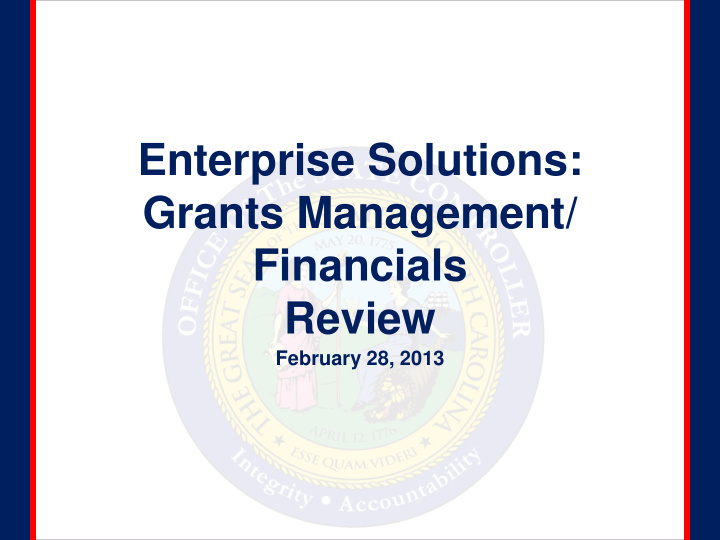



Enterprise Solutions: Grants Management/ Financials Review February 28, 2013
Review of Grants Management Committee Presentation from 12/13/2012 1
Session Law 2012-142 • Grants Management Oversight Committee created and charged with: – Coordination of development of enterprise grants management system to replace all redundant grants management systems – Directing OSBM’s planning and implementation of a new enterprise grants management system – The committee is currently made up of the following members: • David McCoy, State Controller (Committee Chair) • Tom Newsome, Senior Deputy State Controller • Art Pope, State Budget Director • Beth Wood, State Auditor 1
Current Grants Management Systems • NC agencies currently operate more than 20 separate grants management systems • Several agencies are still using fully manual processes Table 1 - Existing Grant Applications Category Applications/Agencies Custom, in-house developed & supported 13 applications Custom, vendor developed & supported 2 applications COTS*, vendor supported 3 applications Software-as-a-Service (SaaS) 3 applications Total 21 applications Manual Processes - No IT Applications 5 agencies *Commercial Off-the-Shelf 2
Grants Management Requirements • OSC conducted business requirements gathering in 2008 • With agency input, OSBM updated the 2008 requirements, with 2 major categories: • State-as-a-grantor • State-as-a-grantee • A comprehensive enterprise grants management system must include the following: • State as a grantor: • Application for non-State entities to receive State grant funds • Payment processing and monitoring • Grantee reporting • Audit • State as a grantee: • Federal draw-down • Reports on use of federal funds 3
Methodology • Study by Gartner, Inc. used to identify Best-of-Breed and ERP grant systems − A Best-of-Breed application is the best application for one particular function, such as grants − An Enterprise Resource Planning (ERP) application performs all business functions, such as finances, grants, fleet maintenance, and HR/payroll, as one integrated system 5
Recommendations • Implement full SAP ERP – SAP is the leading enterprise grants management software for large public sector entities – Financials must be included in order to capture State-as-a- grantee requirements – SAP is the only ERP capable of meeting NC’s needs from both a grants and financials perspective – Additionally, NC already has significant SAP resources • BEACON HR/Payroll operates on an SAP platform • DOT’s ERP implementation was the basis for SAP’s public sector package 8
Recommended Steps: Short-Term • Agencies in need of new grant management systems prior to the implementation of a statewide solution should work with OSBM and DOT to adapt DOT’s existing SAP solution as Best-of-Breed (excluding Financials - Grantor only) • Existing or future grants-related IT projects would be redirected toward the long-term statewide enterprise effort • Agencies taking the short-term approach would move to the statewide solution if that solution is different from the existing • Reauthorize Grants Management Oversight Committee as a Steering Committee, expand to include agency participants agencies with both State-as-grantee and State- as-grantor needs 9
Recommended Steps: Long-Term • Begin implementation of ERP based on recommendations of planning assessment – Anticipated phased implementation, agency-by-agency over 5- year period • Consider centralizing SAP resources in a statewide financial oversight agency with a direct SAP appropriation – Governance decisions would be accomplished through this agency 11
Next Steps: • Update aging financial infrastructure backbone: - Extending State’s existing HR/Payroll ERP to include Financials will help better manage our business by allowing for more customer required integrated functionality. - Increased integrated functionality drives more efficiencies and productivity for the State. 12
Key New Functionality Required Accounts Receivable • Cost Allocation • Fleet and Facilities Management • • Grant Administration (Grantee & Grantor) *excludes potential benefits from code/configuration re-use
Proposed Rollout “NCAS, our existing financial system is aging and lacks key functionality that our customers are demanding.” Replace NCAS Budget – Enterprise design AR, Cost allocation functions, Fleet & HR/Payroll Facilities Mgmt., completed Grants Mgmt. Financials – Full integration – Leverage SAP – Uses SAP platform with ERP system (Phases 2-x) assets and Limited enterprise resources at data structures in OSC & DOT place – OSC Shared Replace NCAS Services and Financials – Implement remaining technical support org agencies (Phase 1) New CAFR reporting, Cash Mgt functions – Interfaces for non- core NCAS agencies HR/Payroll – Sunset agency sub-systems
Estimated Cost • Implementation Costs • $30M/year for 5 years • Once rolled out, estimated on-going O&M costs would be approximately $9M/year. Caveats: • Does not include Universities • Does not include: Budget, E-procurement or Manufacturing 13
Summary • Proactive request to update aging Statewide financial backbone (NCAS). • Fulfills agency business requirements for A/R, cost allocation, fleet/facilities management, & grants management, etc. which create increased statewide efficiencies & productivity through extended integrated workflow benefits. • Provides the State the ability to do program level reporting • Allows ability to leverage existing unused licenses and some subject matter expert (SME) resources. • More efficient to have single enterprise financial backbone versus one-offs. ne-offs.
Questions? 12
Recommend
More recommend